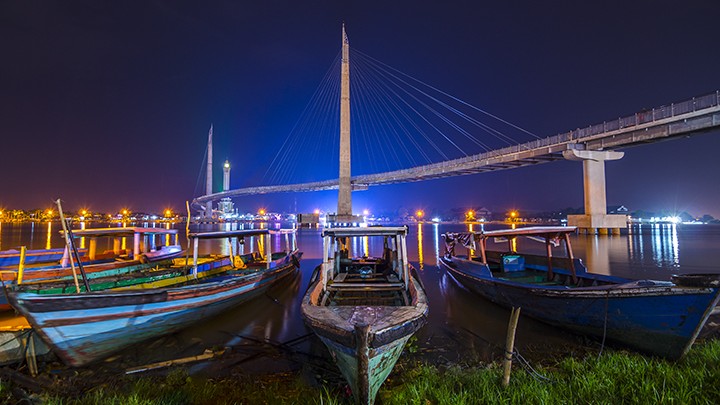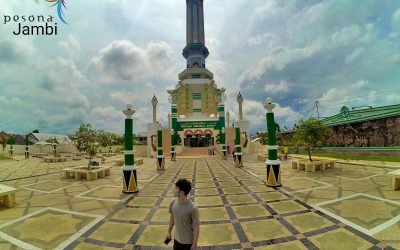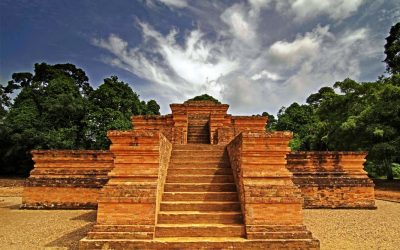Home / Batik Regions – Western Indonesia – Southern Sumatra – Jambi / Batanghari Pedestrian Bridge
Cultural Destination
Embrace the spirit of the place!
Batanghari Pedestrian Bridge
Batanghari Pedestrian bridge is also another iconic landmark of Jambi. This bridge was built in 2012 as a pedestrian route for the locals and as a tourist attraction. With 503 meters in length and 4.5 meters in width, this bridge connects the two lands above the Batanghari River.
Tourist Attractions in Jambi
Gentala Arasy
Built as high as 80 meters, the tower also highlights the historical side of
Muara Jambi Temple
Muara Jambi Temple, built since the 13th Century, is a legacy during the reign of Srivijaya
Jambi
Batik Motifs
Angsa Duo
According to legend, the Angso duo batik motif is a pair of swans that are believed to have led Princess
Durian Pecah
Broken Durian motifs depict the foundation of faith. The second half signifies the mastery of
Merak Ngeram
The hatching peacock motif has a very deep meaning which refers to the sacrifice and
Discover
Indonesian
Batik
Motifs
Gamolan
This motif illustrates Gamolan, a bamboo musical instrument of Lampung that is
Gonggong Beruntun
This motif illustrates that a person should maintain a positive attitude and
Buketan Bali
The Balinese bouquet (Buketan Bali) is a floral arrangement and the name is
Dayak Kamang
Kamang motif is generally found in the Dayak tribe shield because it is believed to
Tabir Tanjung
Tanjung flower is a type of Cherry tree flower, which is commonly found in
Tampuk Manggis Sasirangan
The motif illustrates the philosophy of the mangosteen fruit, which is
Pattimura
Pattimura is the name of an Indonesian hero who fought against colonialism in
Ukir Sentani
The Ukir motif is a batik motif that is inspired by various traditional Sentani wood carvings
Gorga Simeol-Meol
The Gorga Simeol-meol is a pattern of plant tendrils. it is regarded as a symbol of longevity and
Srimanganti
The name of the Srimanganti motif is derived from Palace’s hallway that connects to
Karawo Pinang
Pinang refers to the Palm areca tree. This motif is considered as the original
Manguni Minahasa
Manguni is identified as the symbol of the Minahasa people. Manguni is known as a
Gumin Tambun
Based on Hindu mythology, this motif symbolizes lucks, abundant wealth, and
Enggang Dayak
Local people beliefs that hornbills are an incarnation of the Commander of the Birds. It has supernatural
Pala Salawaku
This motif illustrates the unique weapons of the Maluku region, namely
Kain Cual
Cual textile tradition has existed since the 17th century. The word “Cual” refers to
Tenun Bima
The motifs are adopted from Bima woven textile. This pattern has received a great
Honai
The Honai is inspired by the traditional house of the Papuan community living in
Sekomandi
Its philosophical meaning is the eternal union which refers to a saying “until death do us part”
La Galigo
La Galigo is a literary work of the Buginese Epic that has 300 thousand epic lines. It is considered even
Kaharingan
The Kaharingan or ‘tree of life’ based on the Dayak tribes’ belief system. This tree symbolizes
Salakanagara
Salakanagara batik motif illustrates the first kingdom in the Betawi land
Karawo Mahkuta
Mahkuta refers to Gorontalo’s traditional crown. It represents noble characters of
Tongkonan
Toraja’s traditional house is called Tongkonan. Tongkonan is a place for
Gentala Arasy
Built as high as 80 meters, the tower also highlights the historical side of
Kuda Kupang
Horses symbolize wealth. It contains noble values of virtuous characters that bring
Paqbarre Allo
The word “Barre” means round and “Allo” means the sunlight. This motif is interpreted as
Dayak Taghol
Dayak Taghol has a distinctive style of four curved lines and small dots. This motif represents
Sekar Jati
Sekar means flower and Jati refers to teak trees that symbolizes a strong mental character that
Tanah Liek
The word “Tanah Liek” refers to clay in Minang language. It is also known as
Gurdo Solo
Gurdo or garuda bird is the mount of the Indian god Vishnu. As the Sun Bird,
Kaganga Tanah Rejang
If Batik Besurek combines Arabic calligraphy motifs, then the Kaganga batik takes
Insang Ikan
Insang refers to the gills of the fish. This is a typical pattern of Malay ethnic who inhabits
Pucuk Rebung Riau
Pucuk Rebung symbolizes heart determination in achieving goals, good luck, and
Bale Lumbu
This motif signifies the welfare of the ancient Sasak society. Bale also symbolizes the
Sido Mulyo
Sidomulyo is one of the classical motifs, which is specifically used for the bride’s costume in
Tifa Totobuang
The batik motifs illustrate Maluku’s traditional music instrument called
Biji Kopi
The coffee seeds motif illustrates the pride of local coffee specialities in
Lontara
The Lontara script itself is a typical ancient script of Bugis and Makassar communities. History records that
Ake Patra
Ake is related to the divinity and the composition of the universe. It is a symbol of
Durian Pecah
Broken Durian motifs depict the foundation of faith. The second half signifies the mastery of
Gajah Way Kambas
The motif illustrates the Lampung’s natural reserve, the Way Kambas. it also symbolizes
Gonggong Siput
Gonggong (Strombus Turturella) is one type of sea snail found around
Tubo Kelapa
Coconut tree is a symbol of a good character and strong mentality. It illustrates the more success a person, the more
Gedhog Kembang Waluh
a combination of Javanese cultural motif of the Majapahit kingdom (XII-XIV century) with
Rangkiang
The word “Rangkiang” refers to the rice granary in the Minangkabau language. It symbolizes
Gigi Haruan Lidi
The Gigi Haruan Lidi motif is taken from the name of the cork fish and is a symbol of
Mahkota Siger
Siger is the crown of a noblewoman in ancient time. It is a symbol of femininity, strength, and
Pati-Pati Pinehiku
It symbolizes the hierarchy in society and the social status of the Mekongga
Awan Berarak
Awan Berarak is a combination of Dayak motifs and Malay patterns. The word ‘Awan Berarak’ means the
Daun Simpor
This motif is inspired by the Simpor plant (Dillenia Suffruticosa) which is a typical
Daun Lada Hitam
The black pepper motif represents the main commodity of Bangka Belitung
Prada Papua
The word “Prada” in the Javanese-Indonesian dialect means a batik textile that
Bekantan Pakis
This motif represents Pakis Haji (Polystichum setiferum), an endemic plant in
Merak Ngeram
The hatching peacock motif has a very deep meaning which refers to the sacrifice and
Parang Seling
Parang Seling or “alternating daggers” is a royal batik motif. It is a feminine variant of
Desa Na Tolu
The Desa Na Tolu characteristic pattern symbolizes the Batak philosophy of existence and
Pohon Hayat (Tree of Life)
The Batik motifs in Lampung are dominated by the acculturation of Buddhist and
Besurek Rafflesia
The term “Basurek” refers to a textile that contains letters or inscriptions
Teguh Bersatu
This batik motif shows the strength of the people of Kupang. It also represents a sense of
Jupri Kembang Teh
Kembang Teh illustrates the tendrils of tea plants that grow in the highlands of
Daun Sirih
This motif illustrates betel leaves that are used by Lombok communities as traditional
Bultiya
The word ‘Bultiya’ is an acronym of the three major tribes in North Kalimantan, namely
Lipaq Sabe
Lipaq Saqbe contains a simple geometric classical motif with various flower decorations. This textile is
Leuit Sijimat
This motif reflects the daily activities of the Baduy tribe in Banten. The main ornaments of batik motif consist of:
Sandeq
Sandeq Boat is a symbol of the maritime importance of the West Sulawesi region. The greatness of
Kasih Tak Sampai
‘Kasih Tak Sampai’ is an idiom in the Indonesian language which refers to
Besurek Rembulan
This batik illustrates praise for God who created the wonderful universe
Kerawang Tegak Aceh
The Vertical Upright (Kerawang Tegak) Motif symbolizes a person who has a strong
Wakatobi
It symbolizes the coastal beauty of the Wakatobi island and the symbol of Patra symbolizes
Keluak Daun Pakis
The word “Keluak” is a Minang language which means twisted or tangled. The Motif of
Raja Ampat
Raja Ampat motif represents the marine life at Raja Ampat archipelago in
Tangerang Herang
Tangerang Herang motif is a symbol of Tangerang city. The Tangerang Herang batik motif consists of
Kawung
The Kawung motif was created by Sultan Agung Hanyokrokusumo (1593 – 1645) as a symbolic gift for
Ikan tambal
The word “Ikan” refers to fish. The philosophical meaning of Ikan Tambal means is
Hiu Taliyasan
Indonesia is also home to the world’s largest fish, the whale shark (Rhincodon typus). Hiu Taliyasan refers to



